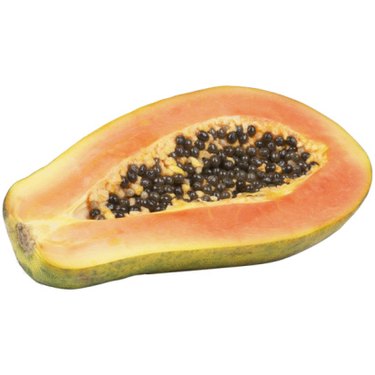
Papaya is a tropical fruit native to Central America and Southern Mexico. The papaya plant is actually a woody herb that grows 10 to 12 feet tall with a cylindrical trunk that ranges anywhere from a few inches to a foot in diameter. The leaf cluster appears mainly on top of the tree with the fruit growing just below it. Papaya trees are prone to infestation from numerous pests including worms.
Pest Identification
Video of the Day
Papaya trees are susceptible to damage from the papaya fruit fly maggots and papaya web worms, also referred to as the fruit cluster worms. The worms damage both the tree and the fruit with their feeding and are among the serious pests of the fruit.
Video of the Day
Description
The papaya fruit flies lay their eggs inside the unripe, 2- to 3-inch fruit. The small emerging larvae are legless and start to feed on the interior sections of the fruit. Once mature the larvae leave the fruit and pupate in the ground, emerging as adults within four weeks. The papaya webworms are caterpillars that grow under a web that they weave with their silk around and between the fruit. The pests also infest the areas between plant stems.
Damage
Papaya webworms feed their way into the fruit and the stems of the tree. Damaged areas become highly prone to infection from the anthracnose fungus. The papaya fruit flies' feeding rots the inner areas of fruit. The pests are nearly impossible to control once the eggs are deposited inside the fruit. Affected fruit are heavily infested with larvae. Papaya varieties with very thick skins are resistant to the damage. Controlling the pest at the commercial level is especially hard.
Control
Use Bacillus thuringiensis as a biological control option for papaya webworms. Other recommended insecticides include permethrin or malathion. For best results, start application of insecticide at the first sign of web presence or immediately at the time of fruit set. Keep fruit safe from the papaya fruit fly by covering young fruit with paper bags very early in the growth period immediately after the flowers have dropped. Replace the bags every 10 to 14 days during fruit development. Use insecticides to kill adults before the eggs are laid. Destroy all dropped or infested small fruit to keep the larvae from developing into adults.